The effect of rapid climate change in the Arctic ecosystem
March 20th, 2016
The Arctic Ocean
Interestingly and coincidentally, “Arctic” comes from the Greek word αρκτος -arctos-, which means “bear” and is a reference to the constellation Ursa Minor, where is the North Star, which indicates the geographic North Pole .
The Arctic constitutes a unique ecosystem of the Earth, consisting of a large ice field, or ice-covered ocean, sometimes regarded as the northern part of the Atlantic Ocean, and it is surrounded by land, which is permafrost, with complete absence of trees. Life in the Arctic consists of organisms adapted to ice, including zooplankton and phytoplankton, fish, marine mammals, birds, land animals, plants and human societies fully adapted to the extreme conditions of the environment.
Due to global warming, isotherms are moving northward at a rate exceeding 50 km per decade over the past 30 years, so if we define the Arctic from a defined temperature or the tree line, its size is diminishing, being the reduction of sea ice the most visible effect.
Anthropogenic climate change: global warming, especially in the Arctic
Yes: climate change is here and it is generated by human activities, that is, it is anthropogenic. Previously there have been on Earth fluctuations in global temperature caused by natural phenomena, usually long-term and cyclical variations. For example, glaciations since about 2 million years are repeated every 100,000 years, and last ice age ended 15,000 years ago. So we are living now in an interglacial period and the next ice age could become not before 50,000 years. The cause of this cycle of glaciations seems to be orbital variations of the Earth, resulting in a lower insolation in high latitudes of the northern hemisphere during glacial periods.
Solar activity, like other stars, has cycles and roughly every 600 years there are periods of little activity (absence of very few solar spots and auroras), with lower energy output, which corresponds to cold periods in the Earth’s climate. The last minimal was in the period 1645-1715, and therefore from the middle of the eighteenth century we enjoy a maximum solar activity, with small cycles of minimum and maximum every 11 years.
Discounting these natural variations, it is clear that throughout the 20th century and especially since the 1960s there has been a steady increase in global average temperature (Figure 1), reaching almost 1ºC more than the beginning of the 20th century. In the early years of the current century the trend is worsening. The last 10 years have been the warmest since there are records, and the forecast is to continue increasing. Most experts agree that humans exert a direct impact on the heating process known as the greenhouse effect. The causes of this effect are some of gaseous components of the atmosphere, especially CO2, which has grown in parallel with rising temperatures, from about 300 ppm at the beginning of 20th century to nearly 400 ppm today. This CO2 and other gases as water vapour, methane and other exclusively anthropogenic absorb radiation and the result is that the atmosphere warms further.
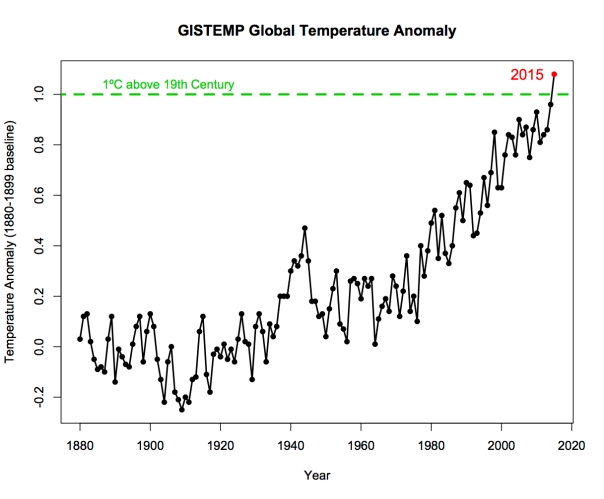
Figure 1. Increase in average global temperature compared to the beginning of 20th century (from GISTEMP).
This global warming is particularly evident in the Arctic. The temperature increases are higher in northern latitudes, especially 60-70º N, where this past December 2015 (Figure 2) have raised to 9ºC above average in large areas of North America and Eurasia. This is called Polar Warming Amplification (PWA). The cause of this overheating in the Arctic respect of the rest of Earth is partly due to the loss of snow and ice (retroactive effect) because the largest area of land and water absorbs more solar energy than white ice (albedo effect), but also the PWA is partly due to the dynamic atmospheric transport, which transports heat energy from the clouds and subtropical regions to the north (Taylor et al 2013).

Figure 2. Thermal anomaly registered in December 2015 with respect to the average 1951-1980 (from GISTEMP).
Besides the consequences of this warming on the Arctic ice that we will comment below, another serious problem is the melting of permafrost, since then methane gas trapped under the frozen ground is released. This way, vast quantities of methane are released, and this greenhouse gas is contributing further to accelerate the global warming.
Less and less ice in the Arctic
Linear trends of sea ice extent and sea ice in the Arctic from 1979 to date are negative year after year, for any month is considered, but it is more clear by comparing Septembers, at the end of the summer when the ice is melting (Figure 3). Of the approximately 7 million km2 minimum in September (the maximum in March is about 16 million), about 100,000 km2 are melt per year, almost 9% every 10 years (Serreze et al 2007), so that there is now almost half ice than in 1979 (Figure 4).

Figure 3. Comparison of the extent of sea ice (in red): September 1979 and 2012 (from The Cryosphere Today).
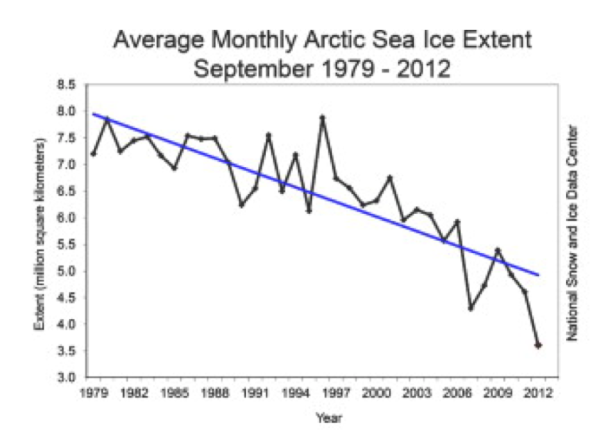
Figure 4. Average monthly extension of Arctic sea ice since 1979 (Reeves et al 2013).
In addition to the reduction in surface ice, keep in mind the reduction in volume, representing now a third of what it was in September 1979.
There is a big difference between the different models for predicting the disappearance of Arctic sea ice. Half of them expect the total disappearance by September 2100. Predictions move since September 2040 the less optimistic until well past 2100 for the other (Serreze et al 2007).
Other problems resulting from the disappearance of sea ice are the ship traffic, which could shorten distances trips between the ports of northern countries, and on the other hand the exploitation of oilfields and other fossil fuels and minerals, since there is a large part of global reserves in the Arctic (Figure 5).
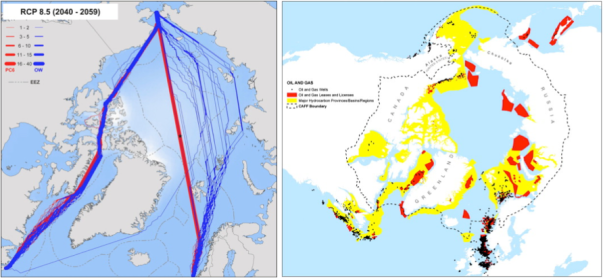
Figure 5. Left: forecast paths for open sea ships (blue) and for icebreakers (red) for 2040-2059. Right: Distribution of the potential major reserves of oil and gas (yellow) and licenses (red) and wells in operation or to operate (black). The dashed line indicates the limit of Conservation of Arctic Flora and Fauna (CAFF) declared by the Working Group of the Arctic Council (www.arctic-council.org). Figures from Reeves et al (2013).
Ecological consequences of the disappearance of the Arctic ice pack
There are many living beings linked to the ice. The polar bears roam on the Arctic ice, so we are feared for his fate. Many fish, seals and crustaceans (krill) form a food chain that starts from the algae that grow under the ice in a very consistent environment, rich in nutrients, especially favourable for marine life (Figure 6 A). Moreover, floating sea ice in summer is a good corridor for dispersion of terrestrial vertebrates (for instance arctic foxes) and plants.
The gradual disappearance of sea ice and warming in the Arctic coast involves a series of ecological imbalances (Figure 6 B). We see for example how walruses forced to remain grouped on the ground are more predisposed to disease transmission. The loss of sea ice diminishes dispersion by ice corridors and then the land populations are most isolated, thus gene flow is restricted. Polar bears and other predators that hunt on the sea ice have it much harder and their populations are at risk. Phytoplankton productivity decreases significantly, thereby reducing zooplankton, and then the whole food chain (fish, seals, etc.) is affected (Post et al 2013).

Figure 6. Ecological interactions influenced by sea ice. A: The distribution and seasonality of sea ice affects the abundance, distribution and interactions of the entire ecosystem in balance. B: The longest period without ice and less sea ice extent have disastrous consequences on the balance of the ecosystem (Post et al 2013).
The polar bear tries to survive
The polar bear (Ursus maritimus) is considered an endangered animal. There are only about 25,000 worldwide. The impact of climate change affects the exclusive habitat of polar regions and forecasts suggest that in a few years from now the ice of the Arctic will melt permanently and polar bears may become extinct because of warming area.
The polar bear is basically carnivorous, unlike others such as brown bears, and remains above the ice hunting seals. With the gradual disappearance of the ice it has more trouble finding preys, and some have begun to learn how to catch salmon rivers, as we see in the images (Figure 7).
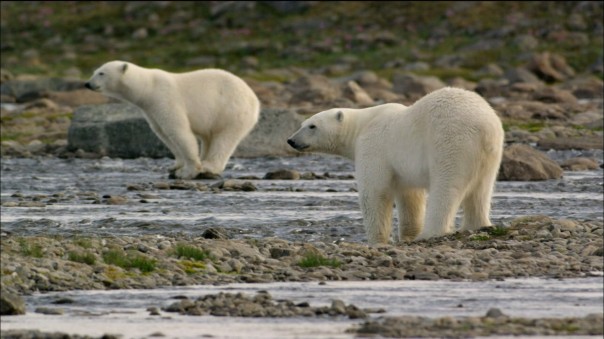

Figure 7. White Bear dedicated to fishing salmons in order to survive (www.youtube.com/watch?v=9m_Q9Ojbcmw).
We have also seen groups of polar bears at sea fishing (see video) and dive emerging alternately as if they were dolphins or porpoises. Despite these small adaptations, the food is very low and it is clear that their populations are declining rapidly.
Orcas thrive north
The disappearance of the northern ice is a dramatic ecological change that is causing the disappearance of some species like the polar bear, but interestingly these imbalances benefit some other emerging species. This is the case of the killer whale (Orcinus orca), which is thriving more and more to the north (Figure 8).
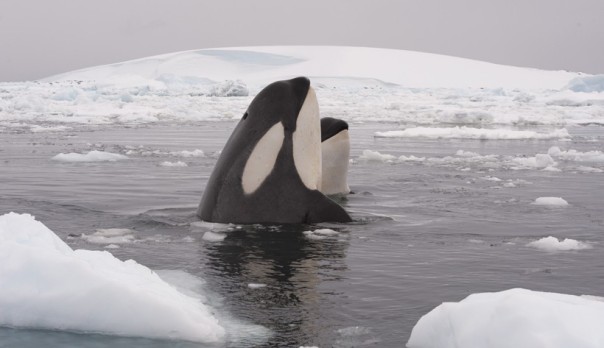
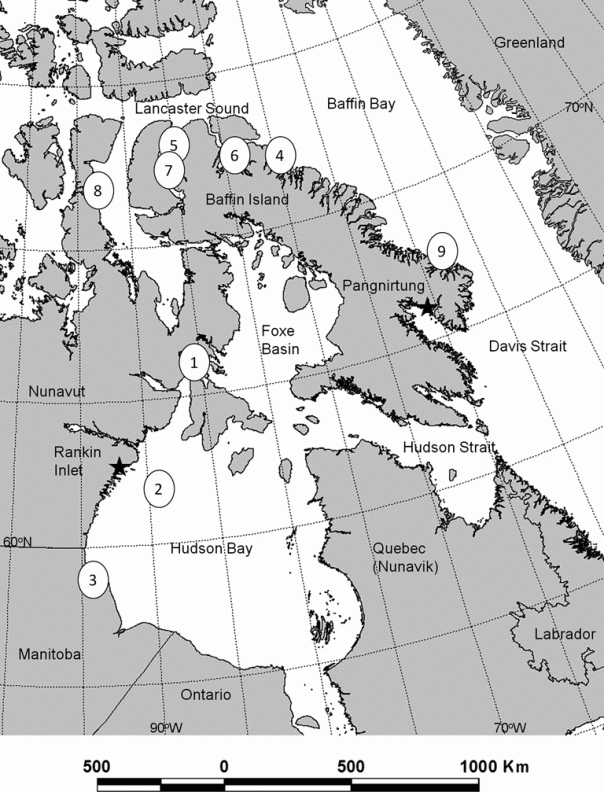
Figure 8. Places (marked with numbers) of the Canadian Arctic where groups of orcas were repeatedly photographed between 2004 and 2009 (Young et al 2011).
Eskimo Inuit people live around the American Arctic (from Quebec to Alaska including Hudson Bay and adjacent islands) and the west coast of Greenland, and they are the first witnesses since the mid-twentieth century observing whales in their waters, unknown before. Moreover, in recent years scientists have made numerous orca’ sightings, they have been photographed individually (Young et al 2011), and their travels have been followed through bioacoustics (Ferguson et al 2010) and other techniques.
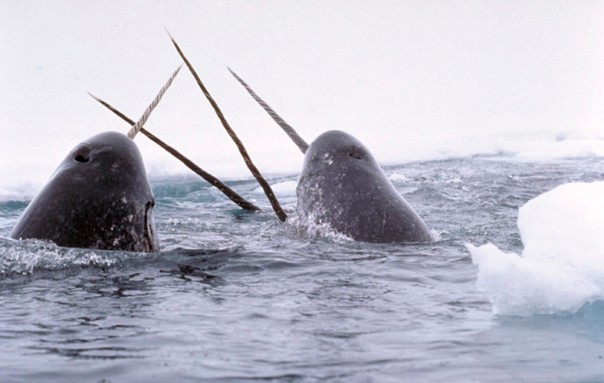

Figure 9. (Top): Narwhals with the characteristic great tusk, which gave rise to the myth of the unicorn. (Low): Group of orcas attacking narwhals cornered on the beach. Watch the video of PBS Nature.
For some years attacks by orcas on narwhals (as in Figure 9) have been observed repeatedly by Inuit Eskimos and studied in detail by several scientists. Laidre et al (2006) observed that before approaching whales, the narwhals tend to group, are more quiet and swim closer to the beach in shallow waters. During the attack, the narwhals disperse significantly but nevertheless mortality is very high. After predation, which can last several hours, oily stains are observed in sea surface, which come from fat of depredated narwhals (Figure 10).
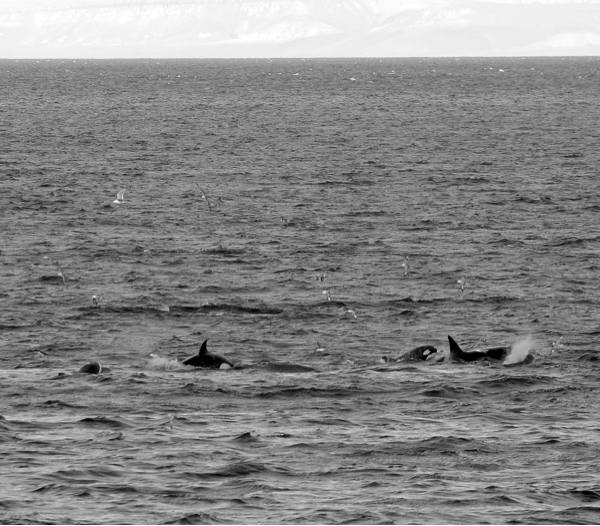
Figure 10. Group of orcas surrounded by patches of oil on the sea surface from the fat of attacked narwhals (Laidre et al 2006).
Orcas’ attacks on narwhals are so common and effective that are beginning to affect the population. The effects are even worse in other cetaceans with smaller population such as whales of Greenland or bowhead (Balena mysticetus), which are now virtually extinct (Figure 11).
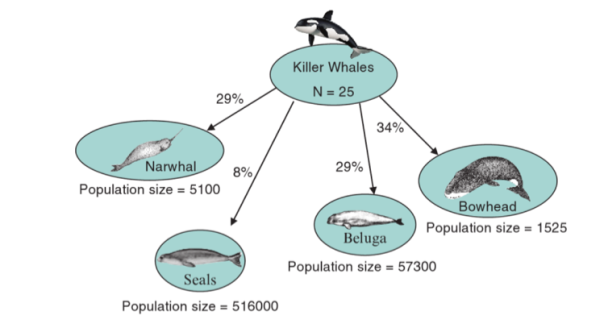
Figure 11. Scheme of preys’ proportions by a group of orcas from Hudson Bay (Ferguson et al 2010).
In conclusion, anthropogenic climate change is affecting the Arctic ecosystem severely (and all the other ecosystems), and although this problem is becoming known, effective policy measures to reduce emissions of CO2 and other greenhouse gases are so scarce that hardly will arrive in time. We are leading the planet Earth to a massive extinction of species and ecological changes ever seen in the history of humans.
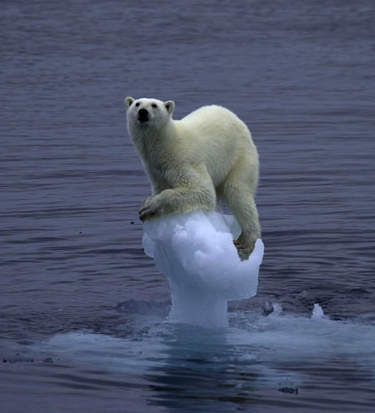
The picture says it all: polar bear habitat is running out.
Bibliography
Arctic Council: http://www.arctic-council.org
Ferguson S.H., Higdon J.W. & Chmelnitsky E.G. (2010) The rise of killer whales as a major Arctic predator. In S.H. Ferguson, et al. (eds.): A little less Arctic: top predators in the world’s largest northern inland sea, Hudson Bay. Pp. 117–136. New York: Springer
GISTEMP, Goddard Institute for Space Studies Surface Temperature Analysis (NASA-GISS): http://data.giss.nasa.gov/gistemp/
Hawkings E (2014) nov 28: http://www.climate-lab-book.ac.uk/2014/hiatuses-in-the-rise-of-temperature/
Laidre KL, Heide-Jørgensen MP, Orr J (2006) Reactions of narwhals, Monodon monoceros, to killer whale, Orcinus orca, attacks in the Eastern Canadian Arctic. Can. Field Nat., 120, 457–465
Morell V (2012) Killer whale menu finally revealed. http://www.sciencemag.org/news/2012/01/killer-whale-menu-finally-revealed
PBS Nature: http://www.pbs.org/wnet/nature/invasion-killer-whales-killer-whales-attack-pod-narwhals/11165/
Post et al. (2013) Ecological Consequences of Sea-Ice Decline. Science. DOI: 10.1126/science.1235225: http://www.carbonbrief.org/knock-on-effects-for-wildlife-as-the-arctic-loses-ice
Reeves RR et al (2014) Distribution of endemic cetaceans in relation to hydrocarbon development and commercial shipping in a warming arctic. Marine Policy 44, 375-389
Serreze MC, Holland MM, Stroeve J (2007) Perspectives on the Arctic’s shrinking sea-ice cover. Science 315, 5818, 1533–6.
Taylor PC, Cai M, Hu A, Meehl J, Washington W, Zhang GJ (2013) Decomposition of feedback contributions to Polar Warming Amplification. J Climate 26, 7023-43
The Cryosphere Today: http://arctic.atmos.uiuc.edu/cryosphere/
Wikipedia: https://en.wikipedia.org/wiki/Climate_change
Wikipedia: https://en.wikipedia.org/wiki/Arctic
Young BG, Jeff W. Higdon JW, Steven H. Ferguson SH (2011) Killer whale (Orcinus orca) photo-identification in the eastern Canadian Arctic. Polar Research Vol 30
Posted on 20/03/2016, in Environment, Evolution, Uncategorized and tagged arctic, climate change, ecosystem, evolution, extinction, ice, life, narwhal, orca, polar, polar bear, water. Bookmark the permalink. 1 Comment.
Pingback: L’efecte accelerat del canvi climàtic a l’ecosistema àrtic | BIOS i altres